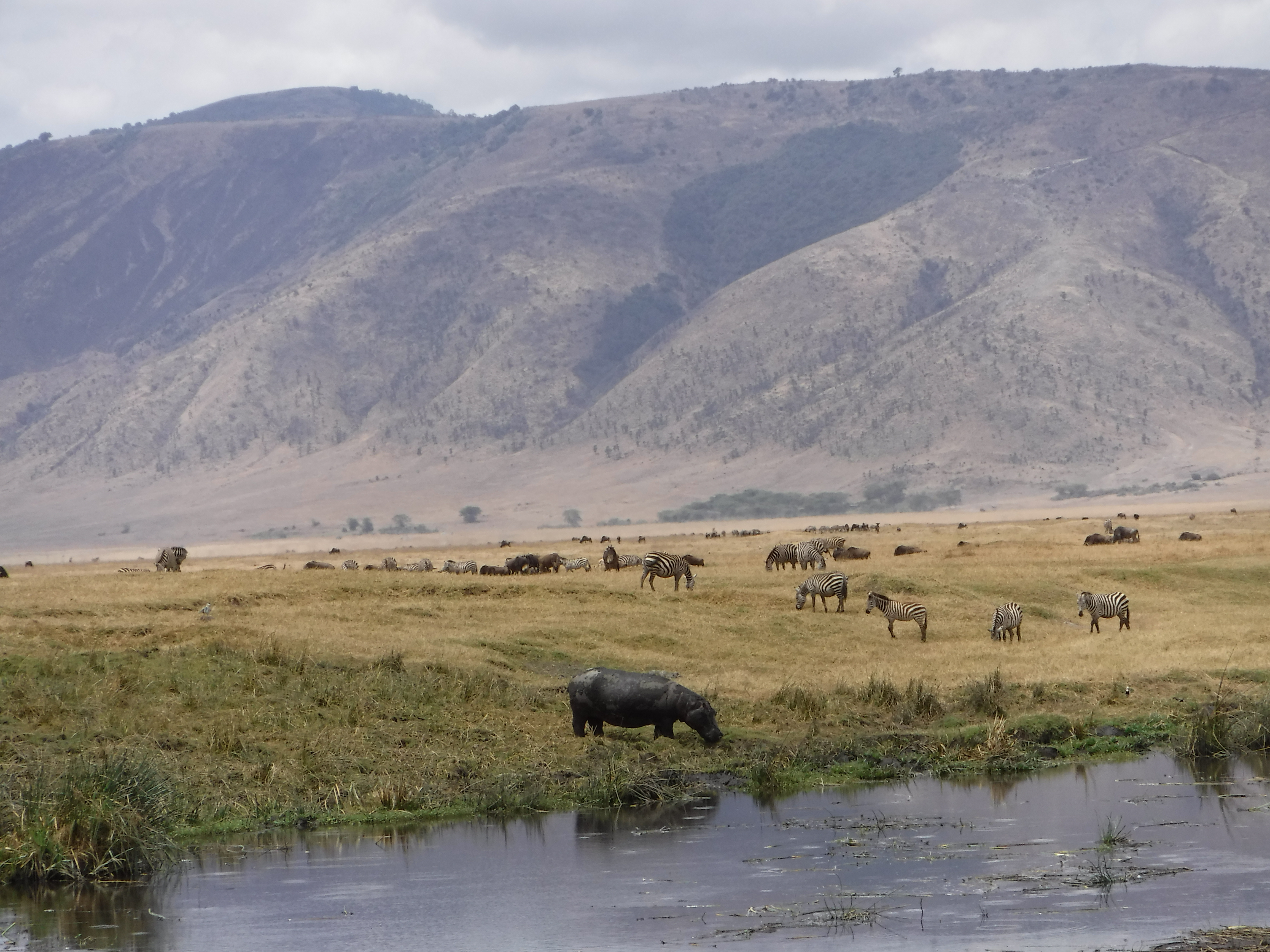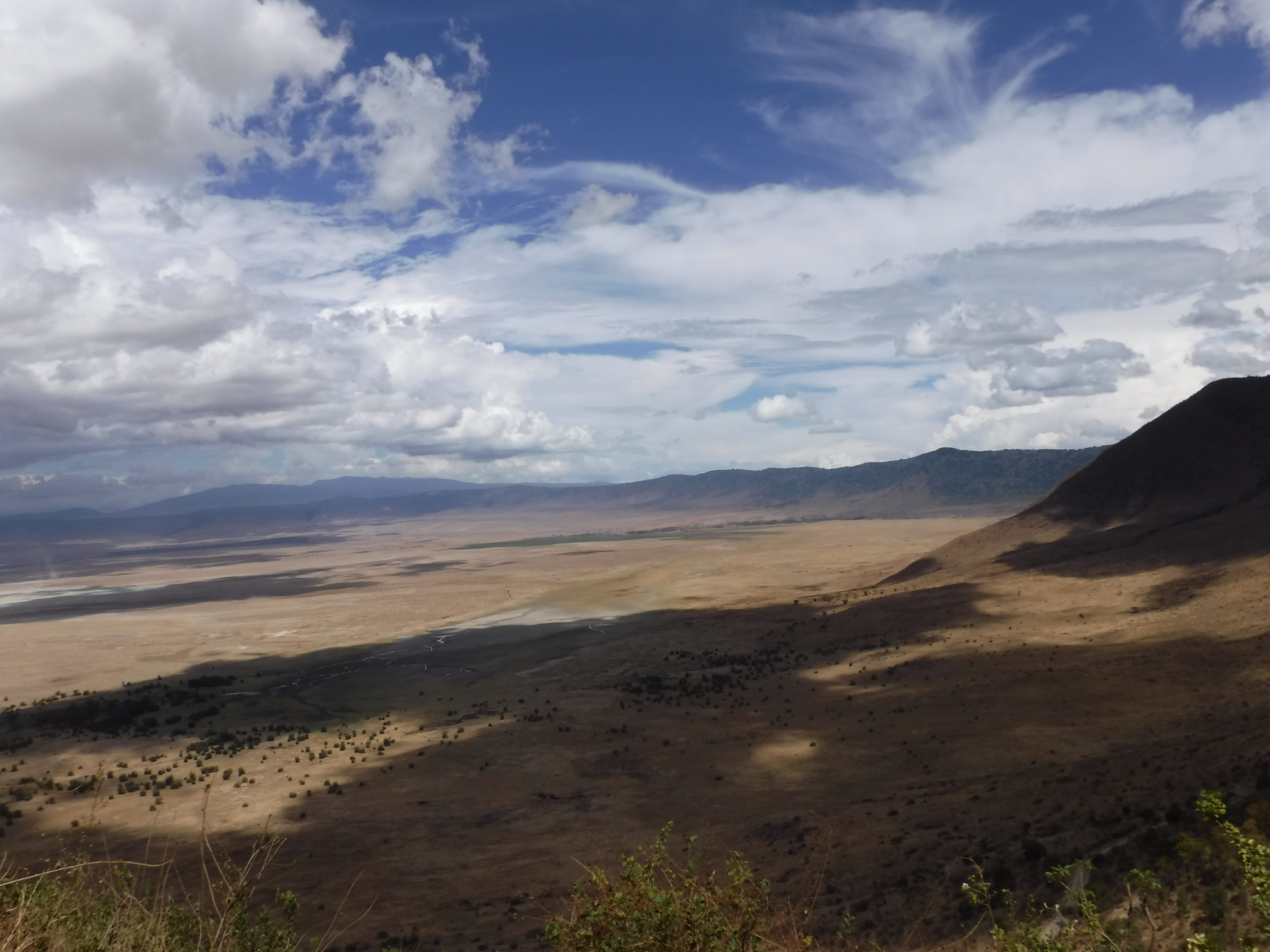Two million years ago, give or take, a giant volcano exploded and collapsed into itself. Ngorongoro is the resulting caldera, the walls of which rise up 2,000 feet from the crater floor. It is claimed to be the largest intact, unfilled caldera on earth. Having spent the last summer around Yellowstone, which is also a giant caldera, I was dubious of the claim, but the Yellowstone caldera rim is broken and eroded enough that you cannot really see a distinct crater in satellite photos. (It is about 5 times the diameter of Ngorongoro though.)
Standing at an overlook point approaching the Ngorongoro caldera, the panoramic view looking north was breathtaking. Heavily forested on the approach from the south, trees cover the peak of the caldera rim in places, flowing down towards the floor like tendrils of fog, following the clouds’ moisture down the slope. The terrain becomes dry grass where the entry road drops down through a series of switchbacks, with patchy acacia trees scattered on the slope. The steep and winding road makes it appear as if it would be challenging for herds of animals to travel in and out of the caldera, but the Maasai people have been herding their cattle in and out for a couple of hundred years.
It was only the year before we visited, in 2015, that they were forced out of the crater itself and back into the surrounding Serengeti plains under a new arrangement with the Ngorongoro Conservation Area Authority. We passed small communities of traditional looking homes, with thatched roofs and arranged in circles, as we neared the caldera northwest rim. Long columns of skinny cattle were being moved by Maasai herders from one range to another.

Our guide Rick stopped at another overlook just before the road wound down the steep mountainside. The view from the northwest corner looked out from a drier patch, the tendrils of clouds visible in the distance snaking over the southwestern ridge.
We made our way down to the caldera floor, stopping frequently to watch the various animals we approached. A herd of wildebeest. Two kinds of gazelle. A pack of hyenas. A pair of crowned cranes. The hyenas were the largest group we had encountered in Africa so far, about ten of them centered around a meal that was too far off and too far consumed to identify.
The first of the Ngorongoro lions we came across were also enjoying a meal, the big male relaxing next to what appeared to be a large buffalo kill, while the female sat a respectful distance away, waiting for her turn. A couple of hyenas paced around yet another distance out, waiting for opportunity to grab a bite. One of them walked across the road quite close to us, on her way back towards the larger group.

They are really not very nice looking animals, but powerful and purposeful. It may not be surprising to learn that the spotted hyena belong to the family of hyenas scientifically described as the “bone-crushing hyenas”, the other group known as the “dog-like hyenas”.
The Mandusi Swamp is the main hippo hangout in the Ngorongoro crater, and there were perhaps 70 or 80 in the water when we arrived, with one or two hanging out on the banks. Herds of wildebeest and zebra were grazing around the watering hole, and black headed ibises rooted around in the muddy grass for whatever treats they favor. One or two white egrets stood on hippos backs, as we had seen on the Chobe River in Botswana.

The lions of Ngorongoro are said to be some of the most closely studied lions in Africa, because they live within a confined space and do not frequently mix with the larger Serengeti population. There is a risk of inbreeding is such a closed environment, and there have been numerous studies to find out how big a problem it is. Reading a study from 1987, Retracing the history of the Ngorongoro lions, by C. Packer & A.E. Pusey (PDF), I learned that the population of around 60 lions in 1960 was decimated by a plague of blood-sucking flies, down to an estimate of 6 to 15 survivors. The flies literally bled the lions to death, with others being killed by the Maasai herders that lived in the crater at the time, as the dying lions desperately went after their cattle. Awful.
This study was looking for tourists that had visited Ngorongoro between 1959 and 1969 to submit any photos that they might have, so researchers could identify the population by facial features. The goal was to figure out if the population rebound after the plague of flies was due to new lions immigrating into the crater, or if the population was entirely inbred. Using old black and white photos!
Apparently the study was a success, and Dr. Craig Packer, the co-author of the study is still researching the lions of Ngorongoro and the Serengeti, at the the University of Minnesota’s Lion Center. The population has varied over the years and it now sits at around 75 lions.
Which is a long and winding way of getting to a highlight of our Ngorongoro visit, we got to watch a pair of lions in the process of making new lions.
I couldn’t help giggling at the end, as she produces a huge yawn and rolls over, paws in the air. It’s hard not to anthropomorphize, but she looks both bored and satisfied at the same time. They walked off a ways and laid back down for a rest, the lion king following his queen.
That was the last notable sighting of our day in the crater. We proceeded out the steep and windy ascent road, paved with cobblestones unlike the bare dirt descent road we came in on. One final overlook for parting shots, and we were soon back at the Ngorongoro Farmhouse and nearing the end of our African adventure. The next day we would take a short flight to the Lobo airfield in Serengeti National Park.
Next up: our last three days at Bologonja Under Canvas, not far from the Mara River and the border with Kenya.
(Click any image for larger versions and captions…)

























Learn much more about the lions of Ngorongoro at the organization, KopeLion, a group that is working to protect the future of lions in the Ngorongoro and Serengeti. They have fantastic detailed histories of each of the lions that they have tracked.

Leave a comment